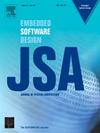DSSE-DMVS: A blockchain-based dynamic searchable symmetric encryption supporting multi-keyword queries and data deduplication
IF 4.1
2区 计算机科学
Q1 COMPUTER SCIENCE, HARDWARE & ARCHITECTURE
引用次数: 0
Abstract
Dynamic Searchable Symmetric Encryption (DSSE) allows users to search for encrypted data and supports dynamic updating of data. In recent years, DSSE has become a research hotspot because it can address privacy and security issues when storing and retrieving encrypted data in cloud environments. However, most of the existing DSSE schemes suffer from inefficiencies in updating data and do not take into account data redundancy due to users misuse. These schemes only support the verification of search result and lack mechanisms to penalize malicious servers as well as ensure fairness to users. To address these issues, we design a blockchain-based dynamic searchable symmetric encryption scheme called DSSE-DMVS. Firstly, we adopt the bitmap as the index data structure to efficiently implement multi-keyword queries and index updates through logical operators AND and XOR. Then, we introduce a data deduplication mechanism to enhance retrieval efficiency and reduce the waste of cloud storage resources. To further penalize malicious servers and ensure fairness for users, we store the actual encrypted files and indexes on the server and blockchain, respectively. Additionally, we use the smart contract to manage the monetary rewards. Formalized safety analysis and experimental results show that DSSE-DMVS is safe and effective in practical applications.
DSSE-DMVS:基于区块链的动态可搜索对称加密,支持多关键字查询和重复数据删除
动态可搜索对称加密(DSSE)允许用户搜索加密的数据,并支持数据的动态更新。近年来,由于能够解决云环境中存储和检索加密数据时的隐私和安全问题,DSSE已成为研究热点。然而,现有的大多数DSSE方案在数据更新方面效率低下,并且没有考虑到由于用户滥用而导致的数据冗余。这些方案只支持对搜索结果的验证,缺乏对恶意服务器的惩罚机制和对用户公平的保证。为了解决这些问题,我们设计了一个基于区块链的动态可搜索对称加密方案,称为DSSE-DMVS。首先,我们采用位图作为索引数据结构,通过逻辑运算符and和XOR高效实现多关键字查询和索引更新。然后,引入重复数据删除机制,提高检索效率,减少云存储资源的浪费。为了进一步惩罚恶意服务器并确保对用户的公平,我们将实际加密的文件和索引分别存储在服务器和区块链上。此外,我们使用智能合约来管理货币奖励。形式化的安全性分析和实验结果表明,DSSE-DMVS在实际应用中是安全有效的。
本文章由计算机程序翻译,如有差异,请以英文原文为准。
求助全文
约1分钟内获得全文
求助全文
来源期刊

Journal of Systems Architecture
工程技术-计算机:硬件
CiteScore
8.70
自引率
15.60%
发文量
226
审稿时长
46 days
期刊介绍:
The Journal of Systems Architecture: Embedded Software Design (JSA) is a journal covering all design and architectural aspects related to embedded systems and software. It ranges from the microarchitecture level via the system software level up to the application-specific architecture level. Aspects such as real-time systems, operating systems, FPGA programming, programming languages, communications (limited to analysis and the software stack), mobile systems, parallel and distributed architectures as well as additional subjects in the computer and system architecture area will fall within the scope of this journal. Technology will not be a main focus, but its use and relevance to particular designs will be. Case studies are welcome but must contribute more than just a design for a particular piece of software.
Design automation of such systems including methodologies, techniques and tools for their design as well as novel designs of software components fall within the scope of this journal. Novel applications that use embedded systems are also central in this journal. While hardware is not a part of this journal hardware/software co-design methods that consider interplay between software and hardware components with and emphasis on software are also relevant here.
 求助内容:
求助内容: 应助结果提醒方式:
应助结果提醒方式:


